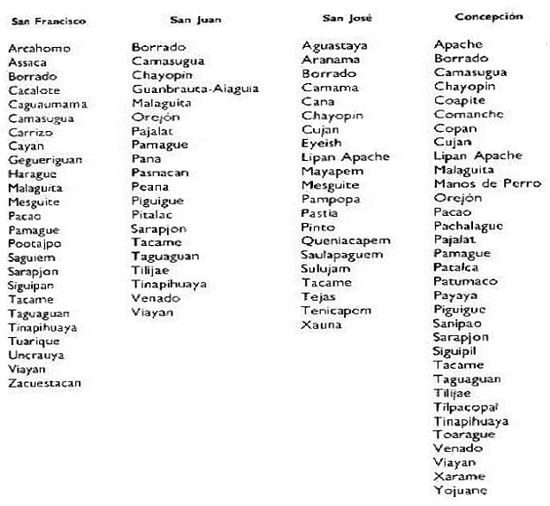Possession of the Missions
On March 05, 1731, four days before the arrival of the Canary Islanders into San Antonio, the Spanish government formally dedicated certain lands and rights for the Native People who had come into the missions. A translated excerpt from the document recording one of the events at San Juan Capistrano Mission, Auto de posecion de la Mission de San Juan Capistrano, reads as follows:
"At the chosen site where San Juan Capistrano was located, on the 5th day of March, 1731, I, Captain Don Juan Perez de Almazan, of the Presidio of San Antonio de Bexar, in the King's name, and on the Orders of Senor Marquez de Casafuerte, Viceroy Governor and Captain-General of the Regency of New Spain and President of the Audencia Real in Mexico where he resides, and by virtue of the faculties that upon me he confers, being on this site with Fray Joseph Urtado, .......the Lieutenant of said presidio, Matheo Perez,...... Xavier Maldonado, alferez, and other persons for the establishment of the expressed mission. The site was chosen for its beauty, arable lands, abundance of water, and pasturage for stock. The location is about three and a half leagues South of Mission Concepcion."
"I took the Chiefs of the Venado and Tilijae Nations, in the name of all of the Indians of those Nations and I escorted them around all of the area composing the Mission. They pulled weeds, threw stones, and performed the other acts of a true and lawful possession so that by the virtue vested in that mission by the Viceroy, they cannot be dispossessed nor have the title voided to the lands, water, and pasturage, without being attended to or heard by the Religious who administer said mission for the Indians aggregated there."
"With my authority as Captain, I named the Governor of said Pueblo the Captain of the Venados, and, in second place, I named the captain of the Tilijaes, these, I placed in possession with the other officials of the Republic so that they can live in the political state, with the assistance of the Christian Doctrine, abstain from public offenses, assist with punctuality the cultivation of the land, construct acequias, raise and husband stock, and perform all of the other ministries that can serve to assist said mission."
(signed)
Juan Antonio Perez de Almazan
The purpose of the Indian missions, according to the authorities, was to educate, and christianize the Natives in order to make them productive Spanish citizens. However, the process of becoming "reduced" whereby the Native would be on "his own" would take ten years, at a minimum. The Native labor was used to build the missions, dig the irrigation canals, herd the cattle and Indians also acted as soldiers against hostile tribes.
Indian labor built all the San Antonio Indian missions including Valero or the Alamo. The construction of these institutions, especially those of Valero and San Jose involved prodigious amounts of materials and labor. The only way that they could have been built was with a very large labor pool. Workers needed to be fed and clothed thereby requiring more manpower to provide foodstuffs for workers and maintenance for stock and draft animals.
The Pajalat (Paa-ha-lot) tribe of Coahuiltecans from Concepcion Mission constructed the irrigation canal along the river from what is near downtown San Antonio today to Concepcion Mission. The canal was very wide and it was said that canoes were used for travel along its length.
The path alongside this canal later was called "Pajalache" (Paa-haa-laa-che) by the Spanish and, more recently, it became South Saint Mary's and Roosevelt Streets.
It has been generally accepted that the friars taught the Native People the farming skills that were required to sustain the missions complex. However, the Friars were experts in those things ecclesiastical and administrative. The expert farmers that taught the Indians were Indians, usually Tlaxcaltecans, originally from the Mexican interior, that had been farming for hundreds of years and had helped colonize the northern part of Mexico.
The Natives did not always conform to the rigid routines imposed upon them. Many tended to return to their independent life, however, the missionaries and the military tried to force them back into the missions if they left without permission.
In 1794, the Spanish government secularized the missions, which, in effect, meant that the remaining Natives were no longer wards of the Catholic Church but were placed on their own. Through the years, many of the Mission Natives assimilated into the Spanish and Mexican society because of the break in their Native tribal customs and culture. In 1890, William Corner wrote, “In the neighborhood of San Juan (Mission) there are more traces of the Indian in faces and characteristics than anywhere else in Texas.”
The descendants of the members of Native tribes took part in the Texas Revolution, in the Battle of Concepcion, and in the Siege of San Antonio in December 1835. They were part of the few that fought who were native Texans in the Revolution. Today, many of their descendants still live in Bexar and Wilson counties in Texas. (See Genealogy)

Appendix I
Maria Esther Dominguez, in her book, San Antonio, Tejas, en la Epoca Colonial (1718-1821), lists the following indian tribes or bands at the San Antonio missions. This does not include San Antonio de Valero, or the Alamo, that had various tribes including Lipan Apaches.